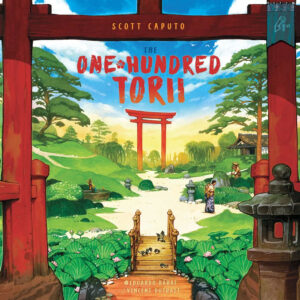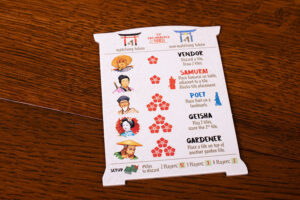 Despite being relatively minimalist in structure, the Japanese Torii is a very identifiable gate. In the world, it’s most commonly found at the entrance of or within a Shinto shrine where it symbolically marks the transition from mundane to sacred. Sound interesting?
Despite being relatively minimalist in structure, the Japanese Torii is a very identifiable gate. In the world, it’s most commonly found at the entrance of or within a Shinto shrine where it symbolically marks the transition from mundane to sacred. Sound interesting?
Well, today we are going to take a leisurely stroll through the gardens as we take a look at The One Hundred Torii, a tile-laying game published by Pencil First Games.
Gameplay Overview:
Games of The One Hundred Torii are fairly easy to learn. Each player starts with a hand of two garden tiles. On a player’s turn, they can optionally enlist the help of one of the five characters. These all help you break the rules in some way but cost you coins or landmark tokens to use.

Then they must add one of their tiles to the garden. Once done, they check to see if they earned any landmark tokens. To do so, they trace a path from a token on the tile they placed to the closest matching one on the board. Doing so earns them one token of that type. In addition to that, any red gate their path traces through earns them an additional token of that type. For every blue gate, they can get a token of a different type.
When a player has 5 tokens of the same type, they can cash them in for a large, 5 point landmark achievement token. Get another five and they can flip it to the 10 side. There are a few other achievement tokens players can claim for using characters or making enclosures. Finally, a player draws to replenish their hand back up to 2 tiles. The game ends when the tile stack runs out. The player with the most points is the winner.

Game Experience:
One of the things I appreciated about The One Hundred Torii is just how streamlined it is. I’m not sure if this is a step up or down in complexity from a game like Carcassonne (probably down), but it’s really easy to learn. Overall, everything just makes sense. Place a tile, match an icon, collect tokens, trade them for point value tokens.

Interestingly, the tokens you earn during the game score you nothing. They can only be used to either get help from a character or claim the achievement tokens. This creates some interesting situations near the end of the game where you are trying to optimize your move for the most points. Since having 4 tokens of a type at the end does nothing for you, it’s all about claiming the achievements.
Which leads me to probably my biggest knock against the game. Near the end, it can devolve into some analysis paralysis for the players. As the garden gets bigger, there are just more and more options to consider. So the end of the game has the potential to grind to a halt as players ponder how to get the most out of their move. This is especially true because of the aforementioned way that garden tokens work. If you can’t get to five on your last turn, the leftovers do nothing for you (short of a tie-breaker). It’s because of this that I think 2-players is the optimal count of the game (unless you are into solo games). I don’t think I ever want to play this with four.
But finding that right path can be fun, and that’s also the crux of the game. What’s interesting is that players will need to decide how lucrative of a path they want to create. While making that path that goes through 5 gates will get you a lot of points, your opponent is going to be able to piggyback off that path on the very next turn.
The other thing I really enjoyed was the variety that the characters interjected into the game. They let you break rules in ways such as covering up a landmark icon, placing a path on top of another path tile, or even blocking someone from placing a tile in a spot. They definitely help add a bit of spice to a game that might have otherwise gotten stale really quickly.

Finally, let’s talk about the components. The artwork by Vincent Dutrait is excellent given he’s also one of the best in the business. The game also included a history of Japanese culture section in the back of the rulebook, which I found really interesting. So that’s the good. The misses in my opinion are in two areas. One being that there are a few player aids in the box, but only one of them is in English. While I can appreciate wanting to accommodate gamers in other languages, literally everything else in the box is in English. So I found this to be an odd decision and somewhat frustrating to pass the player aid around
My other miss was just with the sheer amount of tokens in the box. Setup and teardown can be a bit of a chore and there have definitely been times when I’ve passed on pulling this one off the shelf because I just don’t want to deal with that. I’m not sure if there is a better solution out there for the game (perhaps a scoring track), but as streamlined as the gameplay is, it didn’t match up to the amount of setup and cleanup.
Final Thoughts:
The One Hundred Torii is a good game that’s both easy to learn and has a really nice presentation (for the most part). The five different characters go a long way to stopping games from getting stale, and the copy sent to us also included two mini-expansions which also helped keep things interesting. All in all, we enjoyed our plays of The One Hundred Torii; well everything except the setup and tear down. If you can get past that and enjoy a light tile-laying game, then this one is definitely worth checking out.
Final Score: 3.5 Stars – An interesting tile-laying and matching game that will have you wracking your brain to find the most optimized paths.
 Hits:
Hits:
• Easy to learn gameplay
• Great artwork and background information
• Characters and mini-expansions help keep things interesting
Misses:
• Wouldn’t want to play it above 2 players due to analysis paralysis near the end
• Setup and tear down feels a bit much for the weight of the game






















